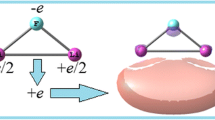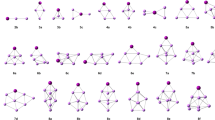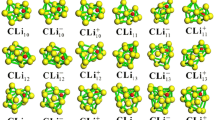Abstract
Herein, we report the theoretical insight into electronic and nonlinear optical (NLO) properties of pure lithium clusters Lin (where n = 3, 5, 7) using MP2/6–311++G(d,p) and DFT theory. The optimization of clusters is carried out at MP2/6–311++G(d,p), while spectral, electronic, and NLO properties are at CAM-B3LYP functional. The studied superalkali clusters are thermodynamically stable, and their binding energies per atom range from − 8.15 to − 15.49 kcal mol−1. The calculated vertical ionization potentials (VIP) and FMOs analysis suggest their superalkali and excess electrons nature. These clusters have significantly reduced HOMO–LUMO gaps (2.78–3.41 eV). The displayed total density of states (TDOS) spectra also provide a more comprehensive picture of electronic characteristics. Being excess electron clusters, the static hyperpolarizability (βo) value is up to 7.77 × 104 au for Li5 where its second hyperpolarizability (γo) significantly increased up to 2.7 × 106 au. There is an excellent correlation between total hyperpolarizability and the computed vector part of hyperpolarizability (βvec). The two-level model (βtl) reveals that excitation energy is the main influencing factor to hyperpolarizability. Besides, dynamic hyperpolarizabilities β(ω) show remarkable values (3.2 × 106 au) for EOPE β( − ω;ω,0) effect at 532 nm. Similarly, the second-harmonic generation (SHG) phenomenon is also much more pronounced at a small dispersion frequency (ω = 532 nm). The dynamic second hyperpolarizability γ(ω) value increases up to 1.2 × 1011 au, and the results are much more pronounced at a larger dispersion frequency (1064 nm). Additionally, the dynamic NLO properties at the applied frequency of 1300 nm are much more pronounced than those of 1900 nm. The significant scattering hyperpolarizability (βHRS) is recorded up to 1.3 × 104 au for Li3 cluster. Hence, the studied lithium-based superalkali clusters are novel candidates for excellent electronic and NLO properties.
Graphical abstract







Similar content being viewed by others
Data availability statement
The author confirms that data supporting finding current study are available within article and in its supporting information. Raw data that support the finding of this study are available from the corresponding, upon the reasonable request.
References
S.N. Khanna, P. Jena, Atomic clusters: building blocks for a class of solids. Phys. Rev. B 51(19), 13705–13716 (1995)
E. Roduner, Superatom chemistry: promising properties of near-spherical noble metal clusters. Phys. Chem. Chem. Phys. 20(37), 23812–23826 (2018)
A.W. Castleman, S.N. Khanna, Clusters, superatoms, and building blocks of new materials. J. Phys. Chem. C 113, 2664 (2009)
I. Colliard, G. Morrison, H.-C. Zur Loye, M. Nyman, Supramolecular assembly of U (IV) clusters and superatoms with unconventional countercations”. J. Am. Chem. Soc. 142(19), 9039–9047 (2020)
K. Yamamoto, T. Imaoka, M. Tanabe, T. Kambe, New horizon of nanoparticle and cluster catalysis with dendrimers. Chem. Rev. 120(2), 1397–1437 (2019)
J. Tong, Y. Li, D. Wu, Z.R. Li, X.R. Huang, Low ionization potentials of binuclear superalkali B2Li 11. J. Chem. Phys. 131, 16 (2009)
G.L. Gutsev, A.I. Boldyrev, DVM Xα calculations on the electronic structure of ‘superalkali’ cations. Chem. Phys. Lett. 92(3), 262–266 (1982)
D. Wang, J.D. Graham, A.M. Buytendyk, K.H. Bowen, Photoelectron spectroscopy of the molecular anions, Li3O - and Na3O-. J. Chem. Phys. 135(16), 1–5 (2011)
S. Giri, S. Behera, P. Jena, Superalkalis and superhalogens as building blocks of supersalts. J. Phys. Chem. A 118(3), 638–645 (2014)
Y.K. Han, J. Jung, Does the ‘superatom’ exist in halogenated aluminum clusters? J. Am. Chem. Soc. 130(1), 2–3 (2008)
P. Huang, G. Chen, Z. Jiang, R. Jin, Y. Zhu, Y. Sun, Atomically precise Au 25 superatoms immobilized on CeO2 nanorods for styrene oxidation. Nanoscale 5(9), 3668–3672 (2013)
T. Zhou, M. Wang, Z. Zang, X. Tang, L. Fang, Two-dimensional lead-free hybrid halide perovskite using superatom anions with tunable electronic properties. Sol. Energy Mater. Sol. Cells 191, 33–38 (2019)
P. Guo, L. Fu, J. Zheng, P. Zhao, Y. Wan, Z. Jiang, Enhanced magnetism in the VLi8 magnetic superatom supported on graphene. Appl. Surf. Sci. 465, 207–211 (2019)
Y. Li, D. Wu, Z.-R. Li, Compounds of superatom clusters: preferred structures and significant nonlinear optical properties of the BLi6-X (X= F, LiF2, BeF3, BF4) motifs. Inorg. Chem. 47(21), 9773–9778 (2008)
R. Arun Kumar, Borate crystals for nonlinear optical and laser applications: a review”. J. Chem. (2013). https://doi.org/10.1155/2013/154862
B.K. Periyasamy, R.S. Jebas, N. Gopalakrishnan, T. Balasubramanian, Development of NLO tunable band gap organic devices for optoelectronic applications. Mater. Lett. 61(21), 4246–4249 (2007)
J. Liu, C. Ouyang, F. Huo, W. He, A. Cao, Progress in the enhancement of electro-optic coefficients and orientation stability for organic second-order nonlinear optical materials. Dye. Pigment. 181, 108509 (2020)
S. Coiai, E. Passaglia, A. Pucci, G. Ruggeri, Nanocomposites based on thermoplastic polymers and functional nanofiller for sensor applications. Materials (Basel) 8(6), 3377–3427 (2015)
H. Yu, N.Z. Koocher, J.M. Rondinelli, P.S. Halasyamani, Pb2BO3I: a borate iodide with the largest second-harmonic generation (SHG) response in the KBe2BO3F2 (KBBF) family of nonlinear optical (NLO) materials. Angew. Chemie Int. Ed. 57(21), 6100–6103 (2018)
G. Yang, Z. Su, C. Qin, Theoretical study on the second-order nonlinear optical properties of asymmetric spirosilabifluorene derivatives. J. Phys. Chem. A 110(14), 4817–4821 (2006)
J. Sun et al., Efficient construction of near-infrared absorption donor-acceptor copolymers with and without Pt (II)-incorporation toward broadband nonlinear optical materials. ACS Appl. Mater. Interfaces 12(2), 2944–2951 (2019)
A. Painelli, Amplification of NLO responses: vibronic and solvent effects in push–pull polyenes. Chem. Phys. 245(1–3), 185–197 (1999)
S.J. Wang, Y.F. Wang, C. Cai, Multidecker sandwich complexes VnBenn+1 (n = 1, 2, 3) as stronger electron donor relative to ferrocene for designing high-performance organometallic second-order nlo chromophores: evident layer effect on the first hyperpolarizability and two-dimensional N. J. Phys. Chem. C 119(10), 5589–5595 (2015)
R.L. Zhong, H.L. Xu, Z.R. Li, Z.M. Su, Role of excess electrons in nonlinear optical response. J. Phys. Chem. Lett. 6(4), 612–619 (2015)
H. Lee, S.-Y. An, M. Cho, Nonlinear optical (NLO) properties of the Octupolar molecule: structure− function relationships and solvent effects. J. Phys. Chem. B 103(24), 4992–4996 (1999)
S. Sajjad, A. Ali, T. Mahmood, K. Ayub, Journal of Molecular Graphics and Modelling Janus alkaline earthides with excellent NLO response from sodium and potassium as source of excess electrons; a fi rst principles study. J. Mol. Graph. Model. 100, 107668 (2020)
A. Ahsin, A. Ali, K. Ayub, Alkaline earth metals serving as source of excess electron for alkaline earth metals to impart large second and third order nonlinear optical response; a DFT study. J. Mol. Graph. Model. 101, 107759 (2020)
W.M. Liang, Z.X. Zhao, D. Wu, W.M. Sun, Y. Li, Z.R. Li, Theoretical study on alkali-metal doped N3H3 complexes: an in-depth understanding of the origin of electride and alkalide and their large nonlinear optical properties. J. Mol. Model. 21(12), 1–9 (2015)
J.J. Wang et al., An external electric field manipulated second-order nonlinear optical switch of an electride molecule: a long-range electron transfer forms a lone excess electron pair and quenches singlet diradical. J. Phys. Chem. C 120, 13656 (2016)
Z.J. Li et al., A dependence on the petal number of the static and dynamic first hyperpolarizability for electride molecules: many-petal-shaped Li-doped cyclic polyamines. J. Phys. Chem. A 113, 2961 (2009)
F. Ullah, N. Kosar, K. Ayub, T. Mahmood, Superalkalis as a source of diffuse excess electrons in newly designed inorganic electrides with remarkable nonlinear response and deep ultraviolet transparency: a DFT study. Appl. Surf. Sci. 483(April), 1118–1128 (2019)
A. Ahsan, K. Ayub, Extremely large nonlinear optical response and excellent electronic stability of true alkaline earthides based on hexaammine complexant. J. Mol. Liq. 297, 111899 (2020)
A. Ahsin, K. Ayub, Theoretical investigation of superalkali clusters M2OCN and M2NCO (where M= Li, Na, K) as excess electron system with significant static and dynamic nonlinear optical response. Optik (Stuttg.) 227, 166037 (2020)
N. Hou, Y.-Y. Wu, H.-S. Wu, H.-M. He, The important role of superalkalis on the static first hyperpolarizabilities of new electrides: Theoretical investigation on superalkali-doped hexamethylenetetramine (HMT). Synth. Met. 232, 39–45 (2017)
Y.-D. Song, L. Wang, Q.-T. Wang, Structures and nonlinear optical properties of alkali atom/superalkali doped pyridinic vacancy graphene. Optik (Stuttg) 154, 411–420 (2018)
W.M. Sun, L.T. Fan, Y. Li, J.Y. Liu, D. Wu, Z.R. Li, On the potential application of superalkali clusters in designing novel alkalides with large nonlinear optical properties. Inorg. Chem. 53(12), 6170–6178 (2014)
J. Hou, D. Jiang, J. Qin, Q. Duan, Alkaline-earthide: a new class of excess electron compounds Li-C6H6F6-M (M= Be, Mg and Ca) with extremely large nonlinear optical responses. Chem. Phys. Lett. 711, 55–59 (2018)
W.-M. Sun et al., A theoretical study on superalkali-doped nanocages: unique inorganic electrides with high stability, deep-ultraviolet transparency, and a considerable nonlinear optical response. Dalt. Trans. 45(17), 7500–7509 (2016)
A.K. Srivastava, N. Misra, Nonlinear optical behavior of LinF (n = 2–5) superalkali clusters. J. Mol. Model. 21(12), 1–5 (2015)
A.K. Srivastava, N. Misra, M2X (M= Li, Na; X= F, Cl): the smallest superalkali clusters with significant NLO responses and electride characteristics. Mol. Simul. 42(12), 981–985 (2016)
A. Ahsin, K. Ayub, Oxacarbon superalkali C3X3Y3 (X = O, S and Y = Li, Na, K ) clusters as excess electron compounds for remarkable static and dynamic NLO response”. J. Mol. Graph. Model 106, 107922 (2021)
J.F. Pérez, E. Florez, C.Z. Hadad, P. Fuentealba, A. Restrepo, Stochastic search of the quantum conformational space of small lithium and bimetallic lithium− sodium clusters. J. Phys. Chem. A 112(25), 5749–5755 (2008)
K. Hirao, Multireference Møller—Plesset method. Chem. Phys. Lett. 190(3–4), 374–380 (1992)
M. Piris, Dynamic electron-correlation energy in the natural-orbital-functional second-order-Møller-Plesset method from the orbital-invariant perturbation theory. Phys. Rev. A 98(2), 22504 (2018)
S. Kossmann, F. Neese, Efficient structure optimization with second-order many-body perturbation theory: the RIJCOSX-MP2 method. J. Chem. Theory Comput. 6(8), 2325–2338 (2010)
D.M. Bates, J.R. Smith, G.S. Tschumper, Efficient and accurate methods for the geometry optimization of water clusters: application of analytic gradients for the two-body:many-body QM:QM fragmentation method to (H2O)n, n = 3–10. J. Chem. Theory Comput. 7(9), 2753–2760 (2011)
A. Ahsin, K. Ayub, Extremely large static and dynamic nonlinear optical response of small superalkali clusters NM3M’(M, M’= Li, Na, K). J. Mol. Graph. Model. 109, 108031 (2021)
J. Elm, K.V. Mikkelsen, Computational approaches for efficiently modelling of small atmospheric clusters. Chem. Phys. Lett. 615, 26–29 (2014)
T. Yanai, D.P. Tew, N.C. Handy, A new hybrid exchange–correlation functional using the Coulomb-attenuating method (CAM-B3LYP). Chem. Phys. Lett. 393(1), 51–57 (2004)
A. Ahsin, K. Ayub, Remarkable electronic and NLO properties of bimetallic superalkali clusters: a DFT study. J. Nanostructure Chem. (2021). https://doi.org/10.1007/s40097-021-00429-2
A. Ahsin, A.B. Shah, K. Ayub, Germanium-based superatom clusters as excess electron compounds with significant static and dynamic NLO response; a DFT study. RSC Adv. 12(1), 365–377 (2022)
A.L. Tenderholt, K.M. Langner, cclib: a library for package independent computational chemistry algorithms. J. Comput. Chem. 29, 839–845 (2008)
B.G.A. Brito, G.Q. Hai, L. Cândido, Analysis of the ionization potentials of small superalkali lithium clusters based on quantum Monte Carlo simulations. Chem. Phys. Lett. 708(June), 54–60 (2018)
C.H. Wu, Thermochemical properties of gaseous Li2 and Li3. J. Chem. Phys. 65(8), 3181–3186 (1976)
F. Ullah, K. Ayub, T. Mahmood, Remarkable second and third order nonlinear optical properties of organometallic C6Li6− M3O electrides. New J. Chem. (2020). https://doi.org/10.1039/D0NJ01670E
H. Ullah et al., Theoretical insight of polypyrrole ammonia gas sensor. Synth. Met. 172, 14–20 (2013)
F. Ullah, N. Kosar, K. Ayub, T. Mahmood, Superalkalis as a source of diffuse excess electrons in newly designed inorganic electrides with remarkable nonlinear response and deep ultraviolet transparency: a DFT study. Appl. Surf. Sci. 483, 1118–1128 (2019)
N. Kosar, K. Shehzadi, K. Ayub, T. Mahmood, Theoretical study on novel superalkali doped graphdiyne complexes: unique approach for the enhancement of electronic and nonlinear optical response. J. Mol. Graph. Model. 97, 107573 (2020)
N. Kosar et al., Significant nonlinear optical response of alkaline earth metals doped beryllium and magnesium oxide nanocages. Mater. Chem. Phys. 242, 122507 (2020)
N. Kosar, T. Mahmood, K. Ayub, S. Tabassum, M. Arshad, M.A. Gilani, Doping superalkali on Zn12O12 nanocage constitutes a superior approach to fabricate stable and high-performance nonlinear optical materials. Opt. Laser Technol. 120, 105753 (2019)
A. Ahsan, K. Ayub, Adamanzane based alkaline earthides with excellent nonlinear optical response and ultraviolet transparency. Opt. Laser Technol. 129, 106298 (2020)
W.-M. Sun et al., Can coinage metal atoms Be capable of serving as an excess electron source of alkalides with considerable nonlinear optical responses? Inorg. Chem. 56(8), 4594–4600 (2017)
A. Ahsin, T. Jadoon, K. Ayub, M@[12-crown-4] and M@[15-crown-5] where (M=Li, Na, and K); the very first examples of non-conventional one alkali metal-containing alkalides with remarkable static and dynamic NLO response. Phys. E Low-Dimens. Syst. Nanostructures 140, 115170 (2022)
A. Ahsin, K. Ayub, Superalkali-based alkalides Li3O@[12-crown-4]M (where M= Li, Na, and K) with remarkable static and dynamic NLO properties; A DFT study. Mater. Sci. Semicond. Process. 138, 106254 (2022)
D. Hou, D. Wu, W.M. Sun, Y. Li, Z.R. Li, Evolution of structure, stability, and nonlinear optical properties of the heterodinuclear CNLin (n = 1–10) clusters. J. Mol. Graph. Model. 59, 92–99 (2015)
J.L. Oudar, D.S. Chemla, Hyperpolarizabilities of the nitroanilines and their relations to the excited state dipole moment. J. Chem. Phys. 66(6), 2664–2668 (1977)
Acknowledgements
The authors acknowledge the financial and technical support from the higher Education Commission of Pakistan COMSATS University, Abbottabad Campus.
Author information
Authors and Affiliations
Corresponding author
Supplementary Information
Below is the link to the electronic supplementary material.
Rights and permissions
About this article
Cite this article
Ahsin, A., Ayub, K. Theoretical investigation of lithium-based clusters Lin (where n = 3, 5, 7) with remarkable electronic and frequency-dependent NLO properties. Eur. Phys. J. Plus 137, 803 (2022). https://doi.org/10.1140/epjp/s13360-022-02971-6
Received:
Accepted:
Published:
DOI: https://doi.org/10.1140/epjp/s13360-022-02971-6




